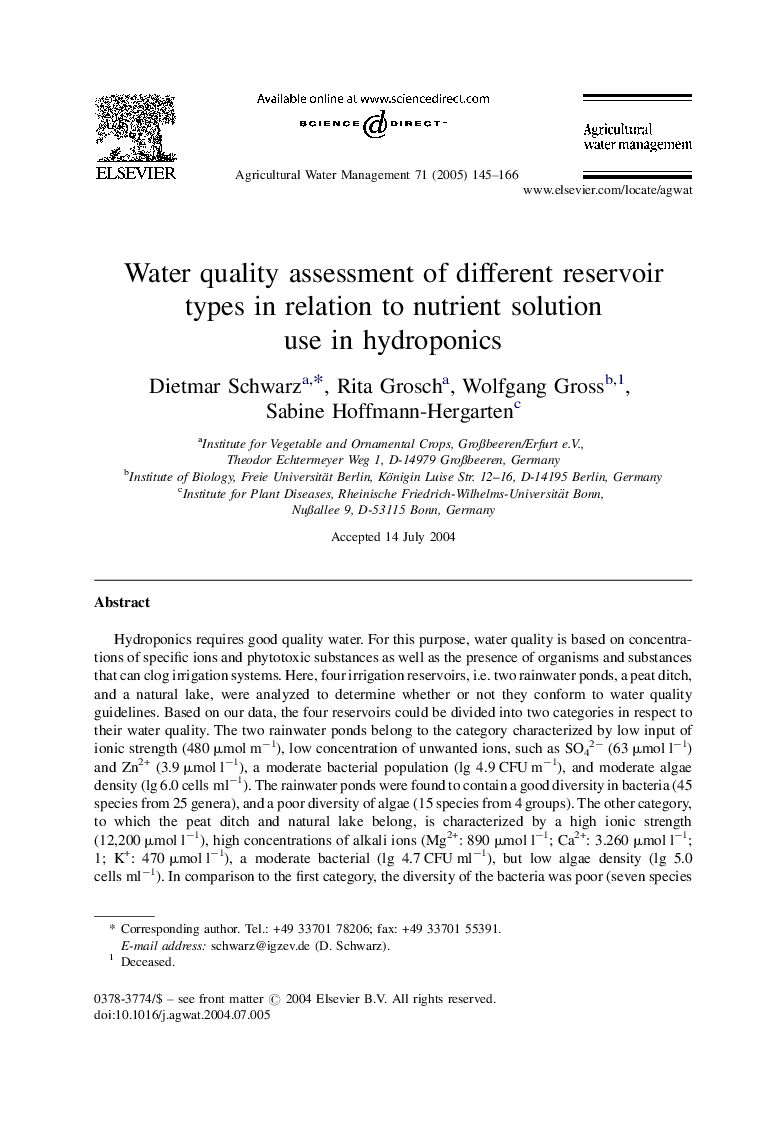| Article ID | Journal | Published Year | Pages | File Type |
|---|---|---|---|---|
| 9467445 | Agricultural Water Management | 2005 | 22 Pages |
Abstract
Hydroponics requires good quality water. For this purpose, water quality is based on concentrations of specific ions and phytotoxic substances as well as the presence of organisms and substances that can clog irrigation systems. Here, four irrigation reservoirs, i.e. two rainwater ponds, a peat ditch, and a natural lake, were analyzed to determine whether or not they conform to water quality guidelines. Based on our data, the four reservoirs could be divided into two categories in respect to their water quality. The two rainwater ponds belong to the category characterized by low input of ionic strength (480 μmol mâ1), low concentration of unwanted ions, such as SO42â (63 μmol lâ1) and Zn2+ (3.9 μmol lâ1), a moderate bacterial population (lg 4.9 CFU mâ1), and moderate algae density (lg 6.0 cells mlâ1). The rainwater ponds were found to contain a good diversity in bacteria (45 species from 25 genera), and a poor diversity of algae (15 species from 4 groups). The other category, to which the peat ditch and natural lake belong, is characterized by a high ionic strength (12,200 μmol lâ1), high concentrations of alkali ions (Mg2+: 890 μmol lâ1; Ca2+: 3.260 μmol lâ1; K+: 470 μmol lâ1), a moderate bacterial (lg 4.7 CFU mlâ1), but low algae density (lg 5.0 cells mlâ1). In comparison to the first category, the diversity of the bacteria was poor (seven species from three genera). However, in sharp contrast was the rich algal community detected in the peat ditch, for which 32 species from six groups were found, whereas in the natural lake, only one group with seven species was identified. In all reservoirs, species of the genera Paenibacillus and Bacillus were detected, and small green algae, e.g. Scenedesmus spp., also dominated in each case. Overall, the bacterial and algal densities showed wide fluctuations between water sources, and neither caused filter clogging as observed in investigations of others. The quality of the rainwater investigated was assessed to be well suited for use in hydroponics due to appropriate nutrient concentration (except Zn2+ in one pond), and lack of potential bacterial and algal development. However, we recommend water from the natural lake and the peat ditch to be used with care because of the high nutrient concentration.
Keywords
Related Topics
Life Sciences
Agricultural and Biological Sciences
Agronomy and Crop Science
Authors
Dietmar Schwarz, Rita Grosch, Wolfgang Gross, Sabine Hoffmann-Hergarten,
